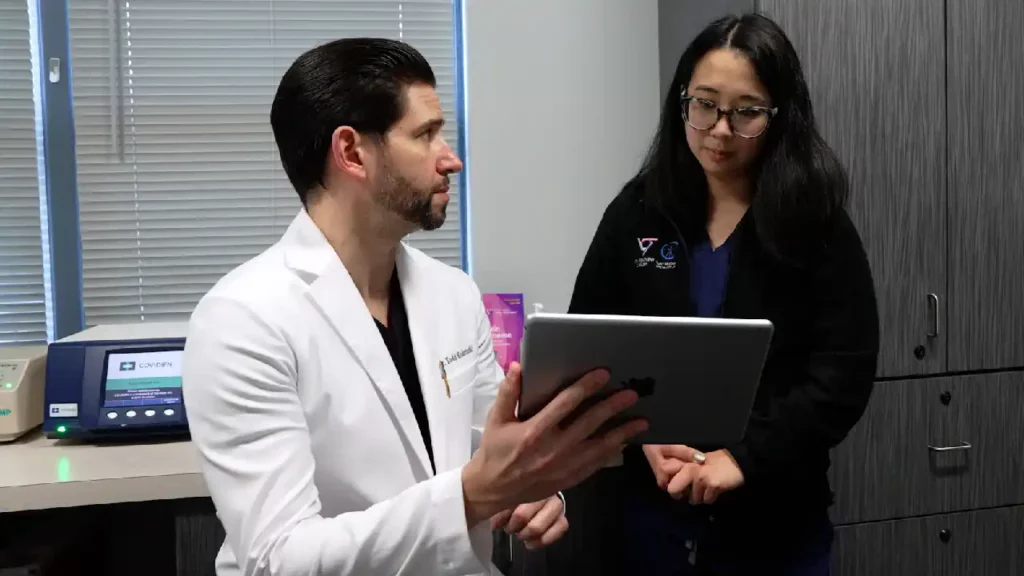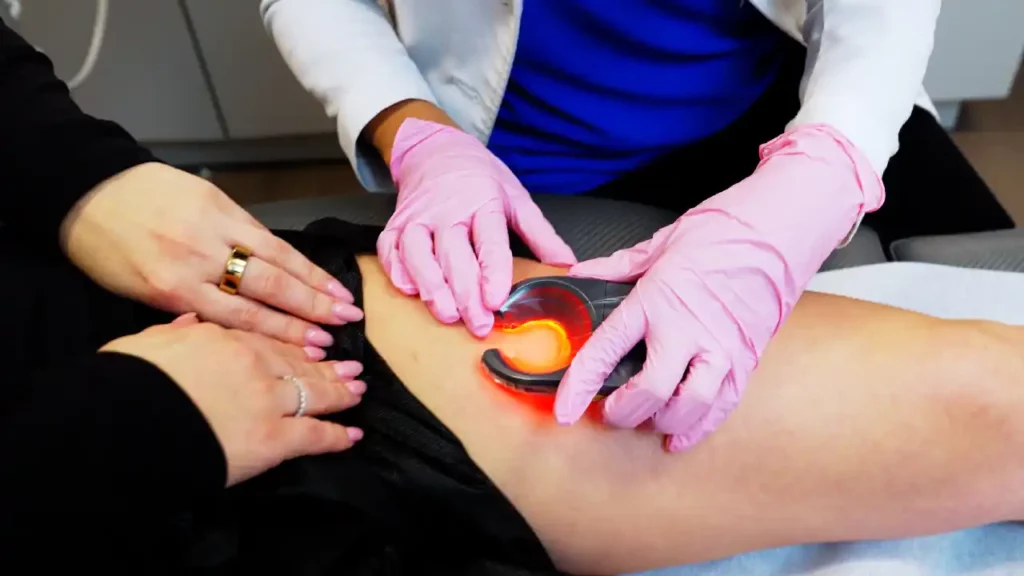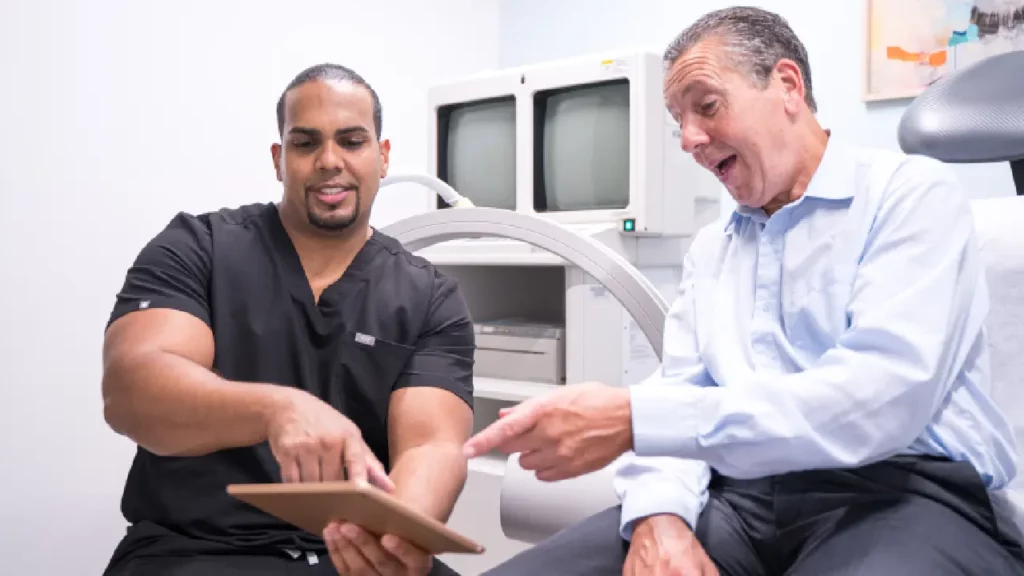Sclerotherapy: What to Expect During and After Treatment
Sclerotherapy is a widely used medical procedure designed to treat varicose veins and spider veins. If you’re considering sclerotherapy, it’s essential to understand what the treatment entails and what you can expect during and after the procedure.
At Vein Treatment Clinic, our board-certified vein doctors provide a detailed overview of what you can expect before, during, and after sclerotherapy and ensure you have all the information you need. In this guide, we will walk you through the entire process, from the initial consultation to the recovery period, so you can make an informed decision about your treatment.
Sclerotherapy: The Basics
What is Sclerotherapy?
Sclerotherapy is a minimally invasive procedure used to treat small varicose veins and spider veins. It involves the injection of a solution directly into the affected veins, causing them to collapse and eventually fade away. This procedure is highly effective and is recommended for patients who experience discomfort or are unhappy with the appearance of their leg veins.
Why is Sclerotherapy Performed?
Sclerotherapy is primarily performed to treat small varicose veins and spider veins, both of which can be unsightly and painful. Varicose veins are swollen, twisted veins that often protrude from the skin’s surface, while spider veins are smaller, web-like veins that can appear red, blue, or purple. The procedure is done for both medical and cosmetic reasons, such as:
- Relief from Symptoms: Sclerotherapy can alleviate symptoms associated with untreated varicose veins, including pain, heaviness, and discomfort in the legs.
- Improved Appearance: Many individuals opt for sclerotherapy to improve the cosmetic appearance of their legs and boost their self-confidence.
- Prevention of Complications: Treating varicose veins early through sclerotherapy can prevent the accumulation of excess blood in the targeted veins, which, in turn, can prevent complications like skin ulcers and blood clots.
Are you interested in getting more information about your condition or a treatment?
Fill the form below to start!
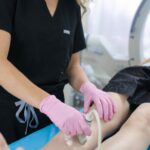
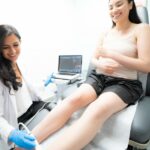
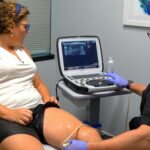
The Consultation Process
At Vein Treatment Clinic, before scheduling sclerotherapy, you will have a consultation with our board-certified vein doctors. During this consultation, several crucial steps occur:
- Medical History: You will be asked about your medical history, including any existing health conditions, medications, and allergies. It is essential to provide accurate information to ensure the safety of the procedure.
- Physical Examination: The vein doctor will perform a physical examination to assess the condition of your veins, their size, and location.
- Discussion of Expectations: This is the time to discuss your treatment goals and expectations with your vein doctor. Be open about whether you are seeking relief from symptoms, cosmetic improvement, or both.
- Vascular Imaging Tests: If your vein doctor notices signs and symptoms of chronic venous insufficiency, the root cause of most vein problems, they may recommend vascular imaging. This is a test that identifies the direction of blood flow in leg veins.
- Treatment Plan: Based on your medical history and the examination results, your vein doctor will develop a personalized treatment plan. They will explain the procedure, potential risks, and expected outcomes.
- Cost and Insurance: You will also discuss the cost of the procedure and whether it is covered by your insurance. Our vein clinics provide free insurance verification before your appointment so you can receive an estimate during your first consultation.
What to Do Before Sclerotherapy
Once you have decided to proceed with sclerotherapy, there are several steps you should take to prepare for the treatment:
- Avoid Certain Medications: Your vein doctor may instruct you to stop taking blood-thinning medications, aspirin, or anti-inflammatory drugs for a specified period before the procedure to reduce the risk of bleeding and bruising.
- Wear Appropriate Clothing: Wear loose, comfortable clothing on the day of the procedure, as you may need to expose the treatment area. Avoid wearing tight stockings or pants that could compress the veins.
- Stay Hydrated: Ensure you are well-hydrated before the procedure, as this can make it easier for the vein doctor to locate and treat the veins.
- Arrange Transportation: Since you may experience some discomfort and swelling after the procedure, it’s advisable to arrange for someone to drive you home afterward.
What to Expect During Sclerotherapy
Sclerotherapy is performed in our state-of-the-art vein clinic and typically takes less than an hour to complete. You will be asked to lie down on an examination table, and the vein doctor will clean the treatment area, usually your legs, with an antiseptic solution. A very fine needle is used to inject the sclerosing solution directly into the targeted veins. You may experience a mild burning or stinging sensation at this point, but it is generally well-tolerated.
After each injection, the vein doctor may apply gentle pressure to the treated area to help disperse the solution and prevent blood from flowing back into the treated veins. Depending on the number and size of veins being treated, multiple injections may be required during the session. The procedure is usually completed within 30 minutes to an hour.
Post-Procedure Care
After sclerotherapy, you will be provided with specific post-procedure care instructions:
- Compression Garments: You may be asked to wear compression stockings or bandages to apply gentle pressure on the treated veins. This helps improve the effectiveness of the treatment and reduces the risk of complications.
- Walking: Walking immediately after the procedure is encouraged to promote blood circulation and reduce the risk of blood clots.
- Avoid Sun Exposure: It’s advisable to avoid direct sunlight on the treated area, as it can cause hyperpigmentation or darkening of the skin.
- Temporary Side Effects: Some common side effects you may experience include bruising, swelling, and mild discomfort. These symptoms are usually temporary and resolve within a few days to a few weeks.
Recovery: What to Expect After Sclerotherapy
The recovery period following sclerotherapy varies from person to person. You can resume most normal activities immediately. However, it’s essential to avoid strenuous exercise, hot baths, and saunas for a few days. It is common to experience bruising and discoloration at the injection sites. These typically fade within a few weeks, but it can take longer for some individuals.
Mild swelling is also common and usually subsides within a few days. You may be instructed to wear compression stockings or bandages for a specified period to support the healing process and reduce the risk of complications. You will have follow-up appointments with your vein doctor to monitor your progress and determine if additional treatments are needed.
When to Call Your Vein Doctor
While sclerotherapy is generally safe, it’s essential to be aware of potential complications and when to seek medical attention. Call your vein doctor if you experience:
- Severe Pain: If you develop severe pain in the treated area that does not improve with over-the-counter pain relievers, contact your vein doctor.
- Infection: Signs of infection, such as increasing redness, warmth, swelling, or discharge at the injection site, should be reported promptly.
- Allergic Reaction: Although rare, some individuals may have an allergic reaction to the sclerosing solution. If you experience symptoms like hives, difficulty breathing, or swelling of the face, lips, or tongue, seek immediate medical attention.
- Blood Clots: If you notice signs of deep vein thrombosis (DVT), such as persistent leg pain, swelling, or redness, contact your vein doctor. DVT is a rare but serious complication.
Results and Follow-up: What to Expect
The results of sclerotherapy are not immediate, and it may take several weeks to months to see the full benefits of the treatment. Over time, the treated veins will gradually fade and become less visible. Some veins may require multiple sessions for complete resolution. You will notice a reduction in the appearance of varicose or spider veins, leading to smoother and clearer skin.
In some cases, follow-ups may be necessary to achieve the desired results. Your vein doctor will assess your progress and recommend additional sessions if needed. It’s important to note that sclerotherapy does not prevent the development of new varicose veins or spider veins in the future. Therefore, maintaining a healthy lifestyle and taking steps to reduce risk factors, such as prolonged sitting or standing, can help prevent new veins from forming.
Schedule Your Consultation Today
Sclerotherapy is an effective and minimally invasive procedure for treating small varicose veins and spider veins. Knowing what to expect during and after the treatment can help you prepare for the procedure and ensure a smooth recovery. Remember that sclerotherapy results are gradual, and you may need multiple sessions to achieve your desired outcome.
If you’re considering sclerotherapy, consult our board-certified vein doctors at Vein Treatment Clinic. Our vein doctors can assess your specific needs, discuss your goals, administer advanced tests, provide personalized recommendations, and guide you through the entire treatment. With proper care and follow-up, you can achieve healthier, more beautiful legs.





